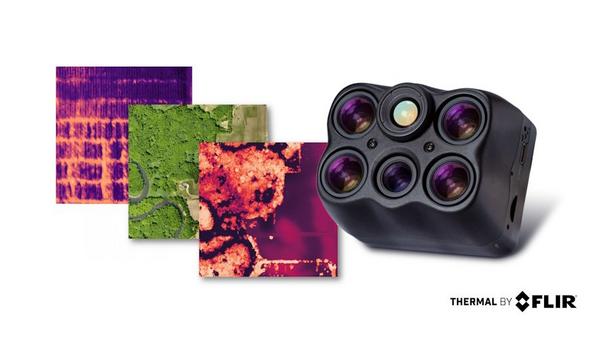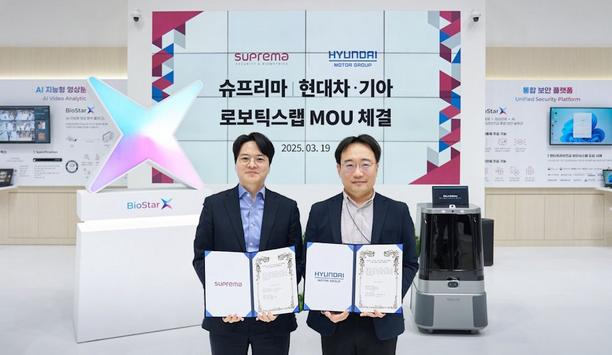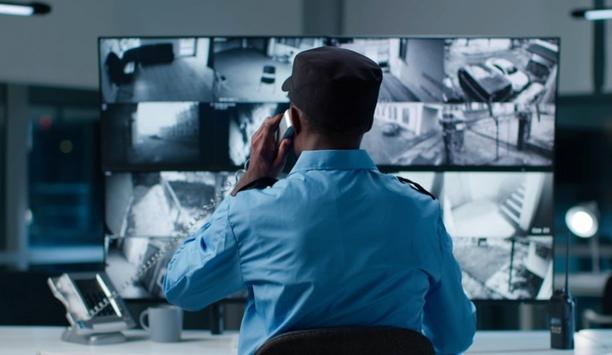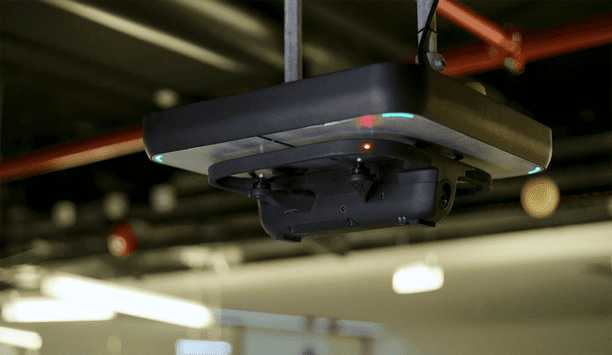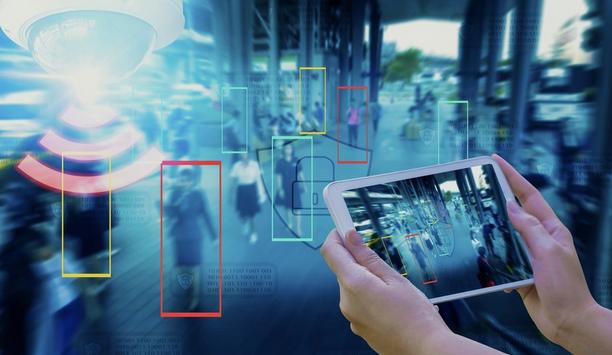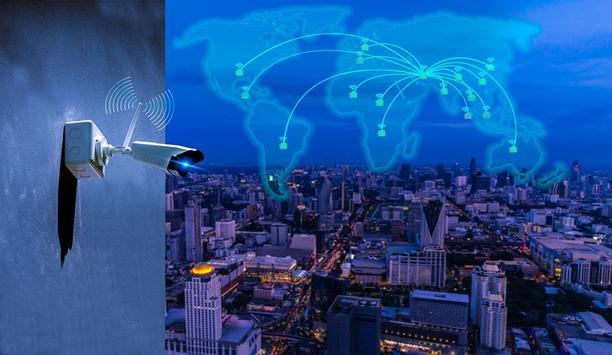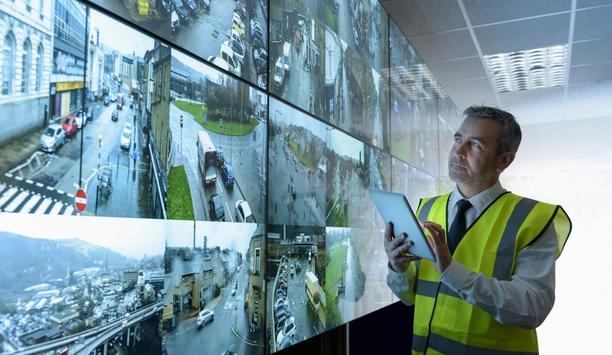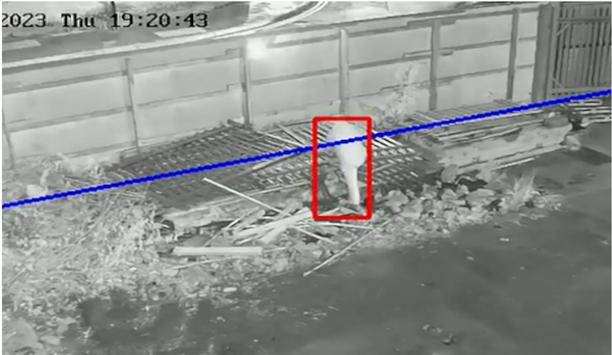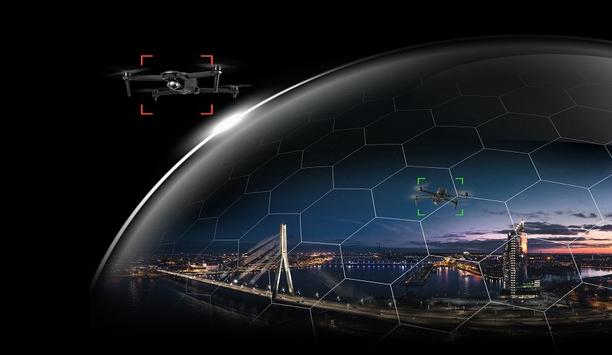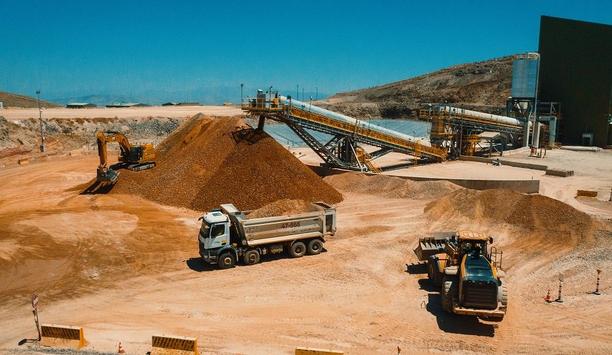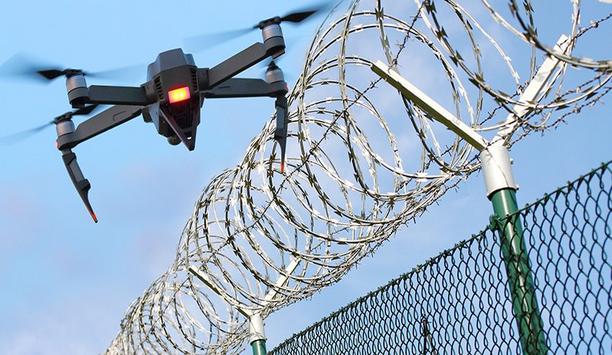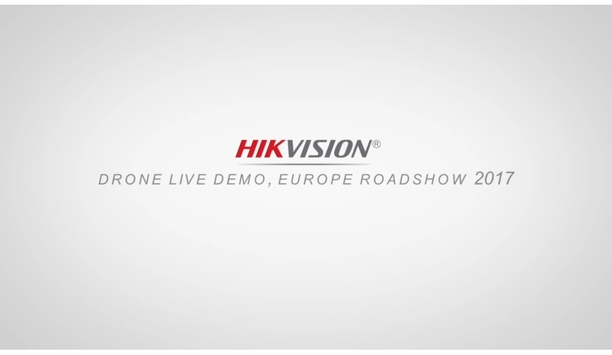Drones
Teledyne FLIR OEM, part of Teledyne Technologies Incorporated, announced that Sentera Sensors and Drones, a pioneering provider of advanced sensors and data, has joined the Thermal by FLIR program. Integrating FLIR Boson® thermal camera modules into the Sentera 6X Thermal Series adds new high-precision thermal mapping capabilities to their integrated multispectral and RGB drone payload platform. Sentera 6X Thermal Series Sentera 6X Thermal Series supports agriculture, outdoor, and in...
FLIR will be showcasing its K-Series thermal imaging cameras with enhanced image quality at FDIC International 2025 in Indianapolis. FDIC International offers thousands of Fire & Rescue professionals from around the world, quality world-class instructors, classrooms, workshops, H.O.T. Evolutions and the most innovative products and services. Discover K-Series Innovations FLIR’s solutions interact with experts to showcase FLIR K-Series, which feature enhanced image qualityAt ex...
Suprema, a pioneer in AI-powered biometric and security solutions, announced the signing of a Memorandum of Understanding (MOU) with Hyundai Motor Group. This partnership will focus on the development of AI and robotics-based total security solutions. This agreement aims to create innovative business models in robotics and physical security by combining Suprema’s globally pioneering AI-based integrated security solutions with Hyundai Motor Group Robotics LAB’s advanced robotics...
VITEC, a market-pioneering provider of IPTV, video streaming and digital signage solutions, showcased its ability to deliver end-to-end solutions for managing, recording, tagging, and retransmitting video streams with a unique workflow demonstration at Silvus Connect Germany 2024. The event – attended by military, government, and first-responder organisations from around the world – provided end users with first-hand experience of Silvus-based mesh networked communication solutions...
Sensor solutions provider HENSOLDT has been awarded a contract by the Federal Office of Bundeswehr Equipment, Information Technology and In-Service Support (BAAINBw) to develop an innovative capability demonstrator for optical detection. The product, called ODAEON, is designed to revolutionise the capability for automated reconnaissance of enemy optical systems on the battlefield and will be developed in cooperation with BAAINBw. Optical reconnaissance systems The aim of the result is a demo...
Sentrycs, a pioneering provider of cutting-edge counter-UAS solutions, has been awarded a multi-million-dollar contract in Latin America for a national defence project. The project marks a significant milestone as the largest installation of counter-drone systems in the region, demonstrating Sentrycs’ unparalleled technological capabilities in addressing the growing threats posed by drones in high-risk environments. Advanced C-UAS systems A strong emphasis will be placed on combating n...
News
Sentrycs, a technology pioneer in the Counter-Unmanned Aerial Systems (C-UAS) industry, announced its continued progress globally within the public safety market. The company recently closed agreements with two new law enforcement organisations, including one in North America. These new agreements will deliver core protocol manipulation sensor solutions across a wide variety of scenarios, from fixed sites to vehicle-mounted (mobile) operations. Drone sightings The company has seen a noticeable spike in C-UAS interest heading into 2025 The deals mark another significant milestone for the company, which has seen its business quadruple, year over year, along with continued adoption of its pioneering technology which is now deployed across sensitive facilities and strategic assets worldwide. The company has seen a noticeable spike in C-UAS interest heading into 2025, especially as, in recent weeks, concerns have grown over unexplained drone sightings throughout several East Coast states in the US. These sightings have prompted calls from both officials and citizens for swift action to identify and mitigate these mysterious flights. Risks to public safety Unregulated or malicious drone activity poses significant risks to public safety and critical infrastructure, ranging from unauthorised surveillance and smuggling to potential terrorist threats where commercially available drones can quickly and inexpensively be weaponized. Addressing these challenges requires sophisticated solutions capable of countering such threats effectively while ensuring no interference with other communication systems that rely on the same frequency bands as the drones themselves. Sentrycs' solution Sentrycs' passively detects, identifies and tracks drones, significantly reducing the possibility of false detections Sentrycs' solution is one of the few available technologies that address these challenges head-on, offering reliable and field-proven capability designed to safeguard public safety with no collateral damage. Leveraging proprietary technology, Sentrycs' passively detects, identifies and tracks drones, significantly reducing the possibility of false detections, a constant challenge encountered with other technologies. Need for kinetic engagements The platform also allows the operator to mitigate (or neutralise) the drone in seconds, directing it to a designated safe landing spot or returning the device to its original home location, avoiding the need for kinetic engagements that often cause collateral damage. "Recent events here in the US, specifically those in New Jersey really highlight the need to monitor unregulated drone activity, as it poses significant risks to public safety and critical infrastructure. Every single day our technology is supporting missions to monitor or mitigate illegal drone activity," said Jason Moore, Chief Revenue Officer at Sentrycs. Challenges of sophisticated solutions Moore added: "Our global footprint means we address a variety of threats from ISR (Intelligence, Surveillance, and Reconnaissance) to enable human trafficking and drug smuggling, to even improvised explosive devices being delivered by the drones themselves." "Addressing these challenges demands sophisticated solutions that counter such threats immediately and effectively without interfering with critical communication systems or causing collateral damage."
PureTech Systems Inc., a pioneer in geospatial AI-boosted video analytics for wide-area perimeter and border security, is proud to announce the launch of its Rapid Deploy Autonomous Perimeter Surveillance System (RDAPSS) configured for Drone detection and tracking. Designed to meet the demands of rapid, flexible security deployments, the RDAPSS delivers unmatched autonomous surveillance and can be equipped with an advanced sensor suite, including counter-drone capabilities. PureTech’s system features RDAPSS is an all-in-one, self-powered solution for organisations requiring reliable drone detection The RDAPSS is an all-in-one, self-powered solution for organisations requiring immediate, reliable drone detection and awareness either as an addition to an existing security system or as a new standalone system. The system features PureTech’s patented AI-boosted video analytics for a near 100% autonomous detection of humans, drones, animals and vehicles, with a near-zero nuisance alarm rate. The RDAPSS adapts to diverse mission profiles, including critical infrastructure protection, border control, special events and temporary facility monitoring. Key features of RDAPSS Rapid Deployment: Designed for ease of transport and installation, RDAPSS can be fully operational within minutes. AI-Boosted Perimeter Surveillance: Equipped with PureTech’s PureActiv® software, RDAPSS delivers real-time, autonomous detection and tracking of targets of interest. Multi-Sensor Integration: Supports a tailorable sensor suite, including radar, cameras, and RF sensors for maximum threat detection. Counter-Drone Capabilities: Detects, identifies, and tracks drones to help mitigate unauthorised aerial threats. Scalable: Operates independently or as part of a larger surveillance network, enhancing operational flexibility. Advanced sensor integrations “As security challenges continue to evolve, the need for adaptable, autonomous surveillance solutions has never been greater,” said Larry Bowe, President of PureTech Systems. He adds, “The RDAPSS combines rapid deployment with advanced sensor integrations and AI-boosted video analytics to address emerging threats, including the growing risks posed by drone intrusions.” RDAPSS empowers security teams With its customisable sensor suite and counter-drone capabilities, RDAPSS empowers security teams to detect and mitigate ground and aerial threats with unmatched precision and efficiency.
The demands on intelligence, surveillance, and reconnaissance (ISR) operations are growing, as the current complex security environment addresses new requirements to support faster and more efficient operations. Legacy ISR systems have struggled to keep up with the vast amounts of surging data volumes, which often translates into delayed decision-making. As a result valuable -- and sometimes vital -- insights are lost, risking mission success and even human lives. So says Mark Rushton, Global Defense and Security Lead at VITEC in a recent vidcast interview for journalists. Role of artificial intelligence In response to these challenges, the ISR community is exploring the role that artificial intelligence (AI) at the edge can play in enabling ISR platforms to filter, analyse, and prioritise data in real-time. By shifting -- and automating -- decision-making capabilities closer to the sources of intelligence, AI at the edge promises to reduce data overload, optimise bandwidth, and improve mission outcomes—all without increasing payload or infrastructure costs. There is mounting evidence the result can be profound, creating a more agile and responsive ISR operation that can quickly identify critical threats and streamline workflows, enhancing efficiency and decision-making. Tackling data overload in ISR Operators face delays and risk missing critical insights during time-sensitive missions One of the main challenges in ISR is managing the overwhelming volume of data. With hours of footage to analyse, operators face delays and risk missing critical insights during time-sensitive missions. “AI at the edge can help alleviate the problem of data overload,” explains Rushton. “By integrating AI into drones and sensors, ISR platforms can analyse data in real-time and proactively identify opportunities to focus on the most salient information, rather than transmitting everything back to the command center by filtering out irrelevant data and highlighting key events.” Improving mission efficiency For example, if AI detects a significant anomaly such as a suspicious object or vessel in an unexpected location during an ocean scan, it can trigger an alert, saving operators from reviewing hours of footage. This approach helps operators focus on actionable insights, reducing workload and improving mission efficiency. Boosting efficiency without added payload The most important imperative, notes Rushton, is to enhance the effectiveness and efficiency of ISR platforms The most important imperative, notes Rushton, is to enhance the effectiveness and efficiency of ISR platforms without adding extra hardware assets -- which increase payload weight -- or additional processing requirements -- that can affect compute performance. These are factors that can reduce mission efficacy. “AI at the edge doesn’t require extra hardware, which is a crucial advantage for platforms,” says Rushton. Real-time decisions “By embedding AI into existing sensors and encoders, systems can make real-time decisions without increasing payload. This reduces operational costs and improves data transmission efficiency.” ISR systems with AI at the edge can also help determine whether to stream high standard-definition footage based on the importance of the data and the availability of bandwidth resources. This optimises transmission quality, delivering the most important data to operators for analysis in the highest-fidelity format possible. Advancing real-time decision-making While AI has been used in recent years to support ISR operations from central command centers, the rapid development of this emerging technology has made it possible to push analytical capabilities closer to the point of data collection, enabling faster and higher-quality intelligence gathering. That said, Rushton stresses that AI at the edge should continue to be seen as an augmentative tool, rather than a replacement, for human analysis. “AI is designed to assist human decision-making,” Rushton notes. “Critical decisions will always stay with human operators, but AI helps by reducing the data they need to process. This allows operators to focus on what’s important, enhancing overall efficiency.” The road to widespread adoption Despite its clear advantages, AI at the edge is still in the early stages of adoption within the ISR community Despite its clear advantages, AI at the edge is still in the early stages of adoption within the ISR community. Many organisations are exploring its potential but remain cautious, particularly regarding the reliability of AI algorithms in real-time mission scenarios. “There’s growing interest in AI at the edge, but for many organisations, it’s still in the conceptual stage,” says Rushton. Scalable, reliable AI application While some elements of AI are already being integrated into sensors and encoders, more testing and strenuous proof of concepts need to be conducted before AI at the edge becomes a mainstream feature of ISR platforms. What is clear is that as the technology matures, its role in enhancing ISR capabilities will continue to grow. “The bottom line,” concludes Rushton, “is that organisations need to start asking the right questions about how AI can fit into their existing systems. By focusing on scalable, reliable AI applications today, they can ensure they’re prepared for the future of ISR operations and remain effective in a constantly evolving intelligence landscape.”
Secutech Thailand opens at the Bangkok International Trade & Exhibition Centre (BITEC), showcasing the latest advancements in security and fire safety and building solutions. The event features a concurrent Fire & Safety event and co-located Building and Architect Thailand, enhancing the exploration of integrated safety and design innovations. Adoption of approaches Visitors have extensive networking opportunities at and beyond exhibitors’ booths With 200 exhibitors from 14 countries and regions showcasing their innovations across 7,500 sqm of solution-specific zones, the three-day fair is designed to provide industry professionals with insights into emerging technologies, facilitating the rapid adoption of transformative approaches. Visitors have extensive networking opportunities at and beyond exhibitors’ booths, including business matching tours and an informative fringe programme, enabling participants to build new business relationships. Demand for robust security Ms. Regina Tsai, General Manager of Messe Frankfurt (HK) Ltd – Taiwan Branch, emphasised the fair’s market potential: “We are excited to showcase a range of ground-breaking technologies tailored to meet users’ unique requirements for optimal protection. The increasing demand for robust security and fire safety measures is propelling the industry forward, fuelled by significant government investments, particularly from the Eastern Economic Corridor, which encompass substantial infrastructure development and initiatives aimed at creating smart cities." "This year’s fringe programme features a strong, diverse line-up of global industry pioneers, enriching the experience for attendees while helping key players capitalise on Thailand’s thriving market landscape.” Integrated security Next-generation technologies, including AI-driven surveillance systems and integrated security Next-generation technologies, including AI-driven surveillance systems, smart fire detection solutions, and integrated security measures for smart buildings, aim to elevate safety, streamline operations, and enhance effectiveness. To complement these advancements, the fair features dedicated solution zones, including the Safety & Rescue Zone, Biometric and Access Control Solution Zone, Platform & Software Zone, and Smart Fire Solution Zone. Each zone provides practical applications and relevant insights, enabling buyers to envision the effective utilisation of the tools on display. Latest trends in security The show has welcomed exhibitors from China, France, Germany, Hong Kong, India, Japan, Malaysia, Korea, Slovenia, Switzerland, Taiwan, Thailand, the UAE, and the US. The diverse product selection from both local suppliers and pioneering global innovators reflects the latest trends in security and fire safety, spanning five main categories – Smart Home and Building Solutions, Access Control, IP Surveillance and AI, Smart Fire Solutions, and Rescue and Disaster Prevention. Advanced intercom systems Highlighted exhibitors in the IP Surveillance and AI category include Mobotix AG and Enzhi Huadatong In the Smart Home and Building Solutions category, notable participants include Xiamen Leelen Technology and Timy, offering advanced intercom systems and seamless smart home integration respectively. In Access Control, key players include Markland Technology and KJ Tech, presenting sophisticated technologies that prioritise security while ensuring user convenience. Highlighted exhibitors in the IP Surveillance and AI category include Mobotix AG, a pioneer in intelligent video systems, alongside Enzhi Huadatong, known for its AI-driven surveillance solutions. Advanced smoke detection technologies In the Smart Fire Solutions category, GEMTEX showcases innovative fire suppression systems, while Securiton AG presents advanced smoke detection technologies. Lastly, in Rescue and Disaster Prevention, Guangzhou Lehmann Fire Equipment provides essential emergency response equipment, complemented by Systronics, which demonstrates drones for disaster management. The fair is also hosting 38 local buyer delegation groups, including representatives from Airports of Thailand, PLC (AOT), Lat Krabang Fire and Rescue Station, Mass Rapid Transit Authority of Thailand, Banbuengcity, and the Royal Police Cadet Academy. These visitors will engage with exhibitors, providing a valuable opportunity for suppliers to showcase solutions and foster potential partnerships that can enhance safety and security initiatives across various sectors. Strategic insights for innovators in cybersecurity Secutech Thailand 2024’s fringe programme promises an exciting lineup of conferences, showcases, and an award ceremony, featuring six distinct sessions that delve into key aspects of security and fire safety: The Innovation TECH Stage: where exhibitors are showcasing their latest developments through live product demonstrations, fostering direct engagement with potential buyers. Topics include: Building Solutions: highlighting sustainable practices and innovative materials, such as green construction methods, and IoT integration. IP Surveillance & AI: examining how these technologies streamline security through centralised management, real-time analytics, and remote monitoring, which are essential for smart buildings and industrial sites. Smart Fire Safety & Rescue: presenting advanced technologies that improve life protection during emergencies, with an emphasis on IoT and AI-powered solutions for improved fire detection and response. Smart Living: showcasing products such as surveillance cameras, access control systems, and IoT innovations designed to bolster security in homes and offices. Cybersecurity Forum for Large Organisations: addressing critical cybersecurity challenges faced by public and private sectors, with executives discussing strategies to strengthen their frameworks. Fire & Safety and Health Conference: exploring current issues in fire safety and health management, aimed at safety experts and those interested in improving workplace safety. Cybersecurity Workshop by the National Cyber Security Agency: a hands-on workshop designed to equip attendees with practical cybersecurity skills. TSA Awards 2024: organised by the Thai Security Association, this event brings together association members for networking, business negotiations, and knowledge exchange, celebrating excellence within the security industry. Safety Drone Conference: exploring innovative applications of drone technology in safety and security, covering UAV technology for security, countermeasures against UAV threats, and workforce preparation for UAV use in crisis situations. Advancements with security and fire safety Secutech Thailand features the concurrent Fire & Safety event, providing a valuable platform for exploring the vital connections between security and safety solutions, which enhances the trade fair experience for both visitors and exhibitors. Additionally, the co-located Building and Architect Thailand underscores the significance of integrating architectural advancements with security and fire safety considerations. Together, these events enable participants to discover comprehensive solutions that address both safety and design, cultivating new business partnerships and encouraging collaboration across various sectors.
The Security Industry Association (SIA) has named Scott M. Gross, facility security officer at Con Edison, as the 2024 recipient of the SIA Insightful Practitioner Award, an honour recognising excellence in promoting the implementation of innovative security solutions. SIA will present Gross with the award on Nov. 20 during the 2024 SIA Honors Night celebration. Scott Gross has over four decades of experience in security and fire protection. In his role at Con Edison, he has played a critical role in improving security practices for one of the nation’s most extensive and complicated utility companies. Latest security technologies All this, coupled with his long experience in deploying the latest state-of-the-art security technologies and proactive stance toward emerging threats, has made him an industry trailblazer. Since joining Con Edison in 2004, Gross has played an invaluable role in mitigating the growing menace of drone activity over critical infrastructure, integrating airspace security solutions to monitor and respond to drone incursions and ensuring comprehensive surveillance and real-time threat assessment. His innovation and strategic vision have made Con Edison much more capable of protecting its operations from potential disruptions. Broader security strategies Gross has been proactive in advocating for legislative changes to enhance the authority of infrastructure Gross has been proactive in advocating for legislative changes to enhance the authority of critical infrastructure operators in mitigating drone threats, contributing to broader security strategies at the state and national levels. Leveraging artificial intelligence and machine learning, he has ensured that Con Edison’s security systems autonomously and accurately detect, track, identify and differentiate drones. In addition to his leadership at Con Edison, Gross is an active member of various industry organisations and advisory boards, using his knowledge and vision to help shape the future of security practices. He holds SIA’s Certified Security Project Manager (CSPM) credential. Approach to securing and monitoring “I am honoured to receive the Insightful Practitioner Award. The Security Industry Association gives me the platform to work with and coordinate with other integrators, consultants and end users to better understand the threats on an international as well as a domestic level against the critical infrastructure,” said Gross. “Together, we can work to create a multilayered approach to securing and monitoring all the critical infrastructure systems of this great country.” SIA’s efforts Gross is a prominent security thought pioneer and has participated in a number of SIA events Gross is a prominent security thought pioneer and has participated in a number of SIA events, conferences and initiatives. His many contributions to SIA and the industry include serving on the SIA Utilities Advisory Board, which develops recommendations and guidance for the physical security and cybersecurity of utilities infrastructure, offers formal responses to security rules and guidance proposed by regulatory agencies, shares knowledge with related industries and develops content for SIA events and publications; sharing his expertise as a speaker at ISC East and ISC West; actively participating in a variety of SIA projects and activities related to critical infrastructure security; and supporting SIA’s efforts related to counter-drone solutions. Impact on the security landscape “SIA is proud to announce Scott Gross as the 2024 recipient of the SIA Insightful Practitioner Award. Scott is an inspiring industry luminary whose zeal for innovation and drive for legislative change have made a great impact on the security landscape, both locally and nationally, and whose deep knowledge and commitment to critical infrastructure protection have made him a sought-after thought pioneer in our industry,” said SIA CEO Don Erickson. “We commend Scott for his impressive accomplishments and valuable contributions to our industry and look forward to recognising him with this special award at SIA Honors Night. We appreciate the trust he has placed in SIA as an effective platform for security practitioner-security supplier collaboration and information sharing.” Implementation of innovative security solutions SIA’s Insightful Practitioner Award was made to honour security practitioners who demonstrate leadership SIA’s Insightful Practitioner Award was created to honour security practitioners who demonstrate leadership and excellence in promoting the implementation of innovative security solutions through education, advocacy and teamwork with the security industry and other stakeholders. SIA Honors Night is a premier event in New York City held concurrently with ISC East – the Northeast’s pioneering security and public safety event, hosted in collaboration with premier sponsor SIA. SIA Honors Night – which includes drinks and networking, a top-quality dinner experience and live entertainment – celebrates exceptional members of the security industry for their leadership, commitment and service to the industry and benefits the work of the Foundation for Advancing Security Talent (FAST). Future of the security industry SIA Honors Night brings together and connects up-and-coming security talent with established industry luminaries for an evening of celebration and supporting the future of the security industry. At SIA Honors 2024, in addition to benefiting FAST’s efforts and presenting the Insightful Practitioner Award, SIA will also present industry pioneers with the George R. Lippert Memorial Award and the SIA Progress Award. SIA Honors 2024 will be held Nov. 20 at HK Hall.
The Security Industry Association (SIA) has appointed Brett Feddersen – vice president of strategy and government affairs at D-Fend Solutions – as chair of the SIA Counter-UAS Working Group. Many facilities are limited in their ability to establish counter-uncrewed aircraft systems (UAS) given the myriad of regulatory nuances and lack of a clear national framework for addressing the topic. UAS National Action Plan SIA Counter-UAS Working Group was created in 2023 to support the work needed to accomplish actively The SIA Counter-UAS Working Group was created in 2023 to actively support the work needed to accomplish the recommendations of the Domestic Counter-UAS National Action Plan put forth by the Biden administration and further educate and give authorities options to mitigate UAS attacks. This group collaborates with external organisations and recruits industry experts aligned with this goal; tracks and monitors supportive legislation; and identifies, educates and engages with legislators. Innovative counter-UAS technologies “I am honoured to continue the hard work my predecessor, Bill Edwards, led in the Counter-UAS working group. Together with my security industry colleagues, we will advance the critical efforts of air domain awareness and safe drone threat mitigation and advocate for the broad acceptance of innovative counter-UAS technologies.” In his role with D-Fend Solutions, Feddersen is responsible for pioneering the company’s strategy, public policy and government relations efforts and engagements with various branches of the U.S. government, policymakers and regulators. He also plays a key role in supporting business development for D-Fend’s airports and aviation practice by supporting the company’s counter-UAS activities at U.S. airports. Roles of Feddersen Feddersen joined the team with vast senior leadership venture in major governmental agents Feddersen joined the team with extensive senior leadership experience in major governmental agencies, including the Federal Aviation Administration, the White House’s National Security Council, the Pentagon’s Joint Chiefs of Staff and the Defense Intelligence Agency. He spoke at SIA GovSummit 2024 on the topic of safeguarding sensitive environments in the era of the hostile drone threat. Feddersen is a U.S. Army combat veteran and a retired Pennsylvania state trooper. New chair of SIA’s Counter “SIA is honoured to welcome Brett Feddersen as the new chair of SIA’s Counter-UAS Working Group,” said SIA CEO Don Erickson. “While uncrewed systems offer tremendous benefits, they also pose security risks across various sectors, and there is a critical need for technologies to address these challenges and safeguard our drone-powered society." "Brett’s deep experience and expertise in navigating the complexities of countering threats will bring great value to the working group’s efforts to inform and educate our members about key topics related to drones and counter-drone technologies and advocate for measures that cater to key requirements while ensuring operational flexibility and continuity." Brett’s leadership SIA Counter-UAS Working Group’s efforts and acts have had to provide input on drone-related content Erickson added: "Through Brett’s leadership and the active involvement of working group members, SIA will continue to actively pursue the renewal of counter-UAS authorities and the long-overdue expansion of these policies to help mitigate threats posed by drones.” The SIA Counter-UAS Working Group’s key efforts and accomplishments have included providing input on counter-drone-related content and pioneering compelling presentations at top SIA and industry events, producing informative articles on important drone and counter-UAS topics, advocating on behalf of the security industry and engaging with legislators on drone-related concerns. Volunteer opportunities Employees of SIA member companies can make the most out of their memberships by getting more involved with the association. Volunteer opportunities include joining SIA committees or groups, lending expertise to SIA’s education and training programs, participating in SIA’s advocacy efforts, contributing to SIA’s publications and thought leadership and getting involved in SIA events.


Expert commentary
As city managers, law enforcement agencies, and first responders face mounting pressure to combat crime and respond to emergencies with limited resources, real-time crime centres empowered by a new generation of data-driven technologies are emerging as an effective force multiplier. Real-time crime centres Real-time crime centres (RTCCs) serve as centralised hubs where dedicated personnel leverage pioneering-edge technologies to analyse diverse data streams and provide critical support to law enforcement and emergency operations. These 24/7 facilities are transforming how agencies gather, process, and act upon information, enabling more proactive and efficient policing strategies. The core functions of RTCCs These centres provide officers with unprecedented situational awareness and real-time intelligence At their core, RTCCs are tasked with three primary objectives: enhancing safety, facilitating identification, and supporting apprehension. By integrating data from a wide range of data sources, these centres provide officers with unprecedented situational awareness and real-time intelligence. Integrated data approach This integrated data approach allows RTCCs to alert officers to potential threats, quickly identify suspects, and guide responders during critical incidents. For instance, in the event of a robbery, RTCC operators can rapidly search camera and licence plate data to track suspect vehicles, significantly improving the chances of a swift arrest. According to the Bureau of Justice Assistance at the U.S. Department of Justice, the mission of an RTCC is to centralise a broad range of current and evolving technologies, coordinate sworn and non-sworn human resources, and direct the attention to high-crime areas, active crimes in progress, high-profile or highly recidivistic offenders, and large-scale public events that may require law enforcement presence or response. The technology powering RTCCs The effectiveness of an RTCC hinges on its ability to seamlessly integrate a wide array of technologies: Open Platform Video Technology: At the heart of many crime centres is an open platform video management software (VMS) that serves as the central nervous system, unifying diverse data streams into a cohesive operational picture. By leveraging open APIs and SDKs, the VMS can incorporate a wide range of cameras, sensors, and analytics tools. This data-driven approach to video technology enables seamless alert distribution to both the RTCC and field officers via mobile applications. IP Camera Networks: The eyes of an RTCC, these systems combine fixed, PTZ, multi-sensor, thermal, and other specialty cameras to provide continuous city monitoring. Strategically placed throughout urban areas, cameras offer comprehensive coverage of critical locations such as transportation hubs, commercial districts, and high-crime zones. This network forms the foundation for real-time monitoring and incident response. Sensor Arrays: Beyond visual data, RTCCs employ various sensor technologies. Acoustic sensors can detect sounds such as gunshots, shouts for help, breaking glass, and other sounds instantly alerting officers and cueing nearby cameras. Environmental sensors monitor air quality for gasses, smoke, and other non-visible hazards. Licence Plate Recognition (LPR): LPR systems act as a force multiplier, continuously scanning for vehicles of interest. By generating real-time alerts for stolen or wanted vehicles, these systems significantly enhance the ability to track suspects and recover stolen property, contributing to reduced auto theft rates. Aerial Surveillance: Many RTCCs incorporate drone technology, providing on-demand aerial perspectives of developing situations. This capability is particularly valuable for monitoring large-scale events, assessing natural disasters, supporting operations in hard-to-reach areas, and serving as a powerful first response for crime scene situational awareness. AI-Powered Analytics: At the heart of many RTCC operations are sophisticated AI algorithms that analyse video data in real-time. These systems can identify a range of suspicious activities, from unattended packages to unauthorised intrusions. By rapidly processing vast amounts of video data, they help operators focus on potential threats and anomalies. Geospatial Mapping: To make sense of the influx of data, RTCCs rely on advanced mapping software. These tools visualise events, alerts, and data streams geographically, allowing operators to quickly identify patterns, clusters of activity, and relationships between incidents. Database Integration: RTCCs maintain direct connections to various law enforcement databases, including local, state, and federal resources like the National Crime Information centre (NCIC). This integration allows for rapid background checks and threat assessments, providing crucial context for ongoing operations. Cloud Infrastructure: The scalability and flexibility of cloud computing are revolutionising RTCC capabilities. Cloud and hybrid solutions offer secure, off-site storage and facilitate easy data sharing between agencies. This approach not only reduces initial costs but also allows for incremental upgrades, making advanced RTCC functionality accessible even to agencies with limited budgets. Real-world impact RTCC operators tracked shooting suspects via camera feeds, guiding officers to their location The proliferation of RTCCs across the United States with over 80 centres in operation speaks to their proven effectiveness. Cities that have implemented these high-tech command centres are reporting significant improvements in response times, clearance rates, and overall public safety. Real-time surveillance In Winston-Salem, North Carolina, the local RTCC leverages over 1,300 live video feeds to provide real-time surveillance across the city. This extensive network, combined with gunshot detection technology and licence plate readers, has already demonstrated its value. In a recent incident, RTCC operators were able to track shooting suspects via camera feeds, guiding officers to their location for a quick apprehension. Video analysis by RTCC Similarly, Newport News, Virginia, saw an immediate impact after launching its RTCC in 2021. The centre has played a crucial role in solving homicides caught on video and rapidly closing a series of carjacking cases. These success stories underscore the game-changing potential of RTCCs when it comes to solving crimes and gathering evidence. In Memphis, Tennessee, video analysis by RTCC detectives helped identify a shooter in custody following an incident at a community basketball court even when no witnesses had come forward. Identifying suspects with RTCC Officers and analysts can view street and body camera footage to monitor crowds at parades The Jackson Police Department in Mississippi has seen similar benefits since building an RTCC in 2019, part of a broader effort that included deploying 100 cameras and 271 body cams. Officers and analysts can view street and body camera footage to monitor crowds at parades and other events. During pursuits, the cameras provide extra surveillance, allowing officers to identify suspects or witnesses to help solve crimes. Enhancing crime mitigation and emergency response While RTCCs have proven their worth in responding to active incidents, their true potential lies in proactive crime prevention and enhanced emergency preparedness. By leveraging advanced analytics and integrated data sources, RTCCs are evolving into powerful predictive tools for law enforcement. Pattern recognition algorithms For instance, pattern recognition algorithms can analyse historical crime data alongside real-time video feeds to identify potential hotspots for criminal activity. This allows law enforcement to strategically deploy resources, increasing visible presence in high-risk areas before crimes occur. Similarly, anomaly detection systems can alert RTCC operators to unusual behaviors or suspicious activities, enabling early intervention in potentially dangerous situations. Asset and property protection, automated alerts RTCCs can monitor critical infrastructure, government buildings, and other high-value assets 24/7 Asset and property protection is another area where RTCCs excel. By integrating with access control systems and using AI-powered video analytics, RTCCs can monitor critical infrastructure, government buildings, and other high-value assets 24/7. Automated alerts for perimeter breaches, unauthorised access attempts, or suspicious objects left in restricted areas allow for an immediate response, significantly enhancing security postures. Emergency response and preparedness In terms of emergency response and preparedness, RTCCs serve as vital command and coordination centres during crises. Whether facing natural disasters, major accidents, or other large-scale emergencies, RTCCs provide a centralised hub for information gathering and dissemination. Real-time video streams from affected areas, combined with data from environmental sensors and emergency service communications, allow for rapid situational assessment and coordinated response efforts. Post-incident investigation and analysis RTCCs can also play an active role in post-incident investigation and analysis. The ability to quickly compile and analyse vast amounts of data from multiple sources can significantly accelerate case resolution and help identify patterns to prevent future incidents. As RTCCs continue to evolve, their capacity for integrating diverse data streams and leveraging advanced analytics positions them as indispensable tools in modern law enforcement strategy. The future of technology-driven policing The integration of artificial intelligence and machine learning promises to enhance video analytics As RTCCs continue to evolve, they are likely to incorporate even more advanced technologies. The integration of artificial intelligence and machine learning promises to enhance video analytics capabilities, enabling faster and more accurate threat detection. Additionally, the expanding use of drones, subject to FAA regulations, could provide RTCCs with cost-effective aerial surveillance options. Effective and ethical operations However, the implementation of RTCCs is not without challenges. Agencies must navigate issues of privacy, data security, and community trust. Ongoing training for personnel and careful planning is essential to ensure these centres operate effectively and ethically. Data-driven approach Despite these hurdles, the trend toward technology-driven policing shows no signs of slowing. RTCCs represent a shift from reactive to proactive law enforcement strategies, offering a data-driven approach to crime prevention and response. As these centres become more prevalent, they will play an increasingly vital role in helping agencies maximise their resources and make informed decisions, ultimately contributing to safer communities for all.
There’s a new security paradigm emerging across malls, server farms, smart office buildings, and warehouses, and its advantage over the status quo are so broad they are impossible to ignore. Instead of a lecture, let’s start with a short narrative scenario to illustrate my point. Darryl's work Darryl works as a security guard at the Eastwood Mall. Like any typical evening, tonight’s shift begins at 9:30 PM, as the stores close and the crowds thin. His first task: Ensure that by 10 pm, all mall visitors have actually left and that all doors, windows, and docks are locked securely. As he walks through most major areas throughout the mall, he checks them off his list. All’s quiet, so after a 45-minute patrol, he stops for a quick coffee break before heading out again. He repeats the process throughout the night, happy to finish each round’s checklist and rest his feet for a few minutes. Challenge: Vandalism during the shift A few cameras located sporadically throughout the mall recorded two dark figures moving in and out of the shadows As usual, there’s nothing notable to report, he clocks out and heads home. The next morning, however, he's greeted by an angry mall manager. He learns that sometime during his shift, three stores were robbed and a back hallway vandalised. A few closed-circuit cameras located sporadically throughout the mall recorded two dark figures moving in and out of the shadows at about 4 am. The mall manager demands an explanation, and Daryl has none, “They must have been hiding during closing time and then waited for me to pass before acting,” he says. “I can only be in one place at one time. And if they were hiding in a dark hallway, I would never have seen them.” Theft explanation “Actually,” explains the manager, “we found a loading door ajar near the furniture store. We’re guessing that’s how they got in, but we can’t be sure. Do you check all the docks? We need to know if we need to replace a lock. Look at your logs - tell me exactly what you saw and when.” Daryl tries to recall. “I'm pretty sure I checked that one a couple of times. I checked it off my list.” Darrell decides not to mention that at 4:00 AM, he was feeling the night's fatigue and might have skipped that area a couple of times. That's the end of our tale. Poor Daryl is not a bad security guard, but he’s only human. His job is repetitive and unstimulating. Darryl's work log He checks off each location for the record, but there's no way for him to record the thousands of details Let’s discuss his hourly log. He checks off each location for the record, but there's no way for him to record the thousands of details he sees to later zoom in on the few observations that might be helpful for an investigation. He has walked by that loading dock door hundreds of times, and it's all a blur. This isn’t an unusual story; Darryl is doing the same job that humans have been doing in almost precisely the same way for millennia. And, like last night, the criminals have always found a way to avoid them. But there is a better way. Solution: Fully-automated indoor drone Replacing a human guard with a fully-automated indoor drone eliminates virtually all the problems we've identified in this story as it flies through the facility: Drone teams can work 24/7: While each drone needs to dock to recharge its battery periodically, a fleet working in concert can patrol around the clock in multiple areas simultaneously. This makes it much more difficult for an intruder to move freely, without risk of discovery. A drone can even keep an eye out and keep recording while docked. Drones see and log everything: Everything is recorded and stored in full detail as they compare what they see with what they expect to see High-resolution onboard cameras and ultrasensitive sensors can detect heat, movement, and moisture, and see into dark areas much more effectively than the human eye. As they aren't limited to the floor, they can also fly high in the air to look above obstacles and at high windows or warehouse shelves. And they don’t lose focus or get bored as the night drags on: Everything is recorded and stored in full detail as they compare what they see with what they expect to see based on a previous flight. Anything unusual triggers an alert. Drones don’t need vacations, snack/bathroom breaks, or new-recruit training: Without the need to deal with biological requirements, you aren't paying for non-work hours, and there’s no overtime for extra hours or holiday shifts. In a high-turnover business like security, there's no time spent training new employees; adding drones to your fleet simply means installing your existing procedures onto each. There is certainly room for judgment calls that require human intervention, but these can often be handled remotely using a control panel that provides all relevant data and alerts from the drones on duty. That means no scrambling to the office in the middle of the night for a false alarm. Drones outshine stationary cameras and the people staring at those screens: A guard in the security office staring at dozens of these screens usually loses their attention span throughout the shift Close-circuit cameras are expensive to install, maintain, and periodically replace. In addition, they are limited in their scope and, almost by definition, leave large blind spots. A guard in the security office staring at dozens of these screens (that generally show nothing notable) usually loses their attention span throughout the shift. Conclusion In short, there is a good reason that our industry is following close on the heels of the manufacturing industry, which has been eagerly adopting robotics as a more cost-effective and precise solution for years. It is simply becoming harder and harder to justify the expense of the traditionally error-prone and monotonous work that we ask of our security guards.
Although video camera technology has been around since the early 1900s, it was not until the 1980s that video started to gain traction for security and surveillance applications. The pictures generated by these initial black and white tube cameras were grainy at best, with early colour cameras providing a wonderful new source of visual data for better identification accuracy. But by today’s standards, these cameras produced images that were about as advanced as crayons and coloring books. Fast forward to 2022, where most security cameras deliver HD performance, with more and more models offering 4K resolution with 8K on the horizon. Advanced processing techniques, with and without the use of infrared illuminators, also provide the ability to capture usable images in total darkness; and mobile devices such as drones, dash cams, body cams, and even cell phones have further expanded the boundaries for video surveillance. Additionally, new cameras feature on-board processing and memory to deliver heightened levels of intelligence at the edge. A new way of doing things But video has evolved beyond the capabilities of advanced imaging and performance to include another level: Artificial Intelligence. Video imaging technology combines with AI, delivers a wealth of new data, not just for traditional physical security applications, but for a much deeper analysis of past, present, and even future events across the enterprise. This is more than a big development for the physical security industry; it is a monumental paradigm shift that is changing how security system models are envisioned, designed, and deployed. Much of the heightened demand for advanced video analytics is being driven by six prevalent industry trends: 1) Purpose-built performance Several video analytics technologies have become somewhat commoditised “intelligent” solutions over the past few years, including basic motion and object detection that can be found embedded in even the most inexpensive video cameras. New, more powerful, and intelligent video analytics solutions deliver much higher levels of video understanding. Vintra custom-built their platform to focus on what matters most to security professionals: speed and accuracy.” This is accomplished using purpose-built deep learning, employing advanced algorithms and training input capable of extracting the relevant data and information of specific events of interest defined by the user. This capability powers the automation of two important workflows: the real-time monitoring of hundreds or thousands of live cameras, and the lightning-fast post-event search of recorded video. Vintra video analytics, for example, accomplishes this with proprietary analytics technology that defines multi-class algorithms for specific subject detection, classification, tracking, and re-identification and correlation of subjects and events captured in fixed or mobile video from live or recorded sources. 2) Increased security with personal privacy protections The demand for increased security and personal privacy are almost contradictory given the need to accurately identify threatening and/or known individuals, whether due to criminal activity or the need to locate missing persons. But there is still societal pushback on the use of facial recognition technology to accomplish such tasks, largely surrounding the gathering and storage of Personally Identifiable Information (PII). The good news is that this can be effectively accomplished with great accuracy without facial recognition, using advanced video analytics that analyse an individual’s whole-body signature based on various visual characteristics rather than a face. This innovative approach provides a fast and highly effective means of locating and identifying individuals without impeding the personal privacy of any individuals captured on live or recorded video. 3) Creation and utilisation of computer vision Computer vision-driven video analytics transform professional video security systems from being purely reactive to proactive and pre-emptive solutions.” There are a lot of terminologies used to describe AI-driven video analytics, including machine learning (ML) and deep learning (DL). Machine learning employs algorithms to transform data into mathematical models that a computer can interpret and learn from, and then use to decide or predict. Add the deep learning component, and you effectively expand the machine learning model using artificial neural networks which teach a computer to learn by example. The combination of layering machine learning and deep learning produces what is now defined as computer vision (CV). A subset but more evolved form of machine learning, computer vision is where the work happens with advanced video analytics. It trains computers to interpret and categorize events much the way humans do to derive meaningful insights such as identifying individuals, objects, and behaviours. 4) Increased operational efficiencies Surveillance systems with a dozen or more cameras are manpower-intensive by nature, requiring continuous live or recorded monitoring to detect and investigate potentially harmful or dangerous situations. Intelligent video analytics, which provides real-time detection, analysis, and notification of events to proactively identify abnormalities and potential threats, transform traditional surveillance systems from reactive to proactive sources of actionable intelligence. In addition to helping better protect people, property, and assets, advanced video analytics can increase productivity and proficiency while reducing overhead. With AI-powered video analytics, security and surveillance are powered by 24/7 technology that doesn’t require sleep, taking breaks, or calling in sick. This allows security operations to redeploy human capital where it is most needed such as alarm response or crime deterrence. It also allows security professionals to quickly and easily scale operations in new and growing environments. 5) A return on security investment “With video analytics, what has always been regarded as a cost centre is now being looked at as a profit centre.” The advent of advanced video analytics is slowly but surely also transforming physical security systems from necessary operational expenses into potential sources of revenue with tangible ROI, or as it is better known in the industry, ROSI – Return on Security Investment. New video analytics provide vast amounts of data for business intelligence across the enterprise. Advanced solutions can do this with extreme cost-efficiency by leveraging an organization’s existing investment in video surveillance systems technology. This easy migration path and a high degree of cost-efficiency are amplified by the ability to selectively apply purpose-built video analytics at specific camera locations for specific applications. Such enterprise-grade software solutions make existing fixed or mobile video security cameras smarter, vastly improving how organizations and governments can automatically detect, monitor, search for and predict events of interest that may impact physical security, health safety, and business operations. For example, slip-and-fall analysis can be used to identify persons down or prevent future incidents, while building/area occupancy data can be used to limit crowds or comply with occupancy and distancing guidelines. In this way, the data gathered is a valuable asset that can deliver cost and safety efficiencies that manual processes cannot. 6) Endless applications The business intelligence applications for advanced video analytics platforms are virtually endless including production and manufacturing, logistics, workforce management, retail merchandising and employee deployment, and more. This also includes mobile applications utilising dashboard and body-worn cameras, drones, and other forms of robotics for agricultural, oil and gas, transportation, and numerous other outdoor and/or remote applications. An added benefit is the ability to accommodate live video feeds from smartphones and common web browsers, further extending the application versatility of advanced video analytics. Navigating a busy intersection The accelerated rate of development for new advanced video analytics makes the intersection of video and AI technologies a very busy one to navigate. Just like crossing the street, one needs to be cautious in their approach. There are a lot of players entering this space who are making big statements and claims about their solutions. When vetting a provider, consider that it’s all about how they develop their technology, the accuracy they deliver, and their ability to leverage this new source of data to improve the specific outcomes you need to achieve. And most of all, it’s about proof of performance and how they arrived at the desired outcomes. Navigate your way across this busy intersection pragmatically, and you will find intelligent video analytics to be a real game-changer for your organisation’s physical security operations.
Security beat
With the year 2025 stretched out before us, there are many techniques one could use to predict what will happen in the new year. You might analyse historical data and analyse future trends. Or you could try statistical or economic modelling. Or you could develop multiple scenarios based on various assumptions to explore potential outcomes. Or you could just check your email. At this time of year, my email is full of industry folks looking to predict what the future holds in 2025. Ranging from artificial intelligence (AI) to privacy, the retail market to drones, here is a sampling of forecasts for 2025 provided by various players in the security market, courtesy of my email messages. What’s Ahead for AI? From Faisal Pandit, VP & GM, Global Security Products, Johnson Controls (JCI): “The future of security operations includes customisable, scalable solutions where users can control if, when, and how they use AI to improve efficiency depending on the size and function of their organisation.” Says Kevin Woodworth, Vice President, Global Product Management, Intrusion, JCI: “Next year will see a growing focus from product developers on designing systems that streamline setup and configuration through increased AI integration. This reflects a broader trend of leveraging AI to simplify use and enhance adaptability as solutions evolve, rather simply employing it because it’s popular.” From Peter Evans, CEO of Xtract One Technologies: “AI algorithms will significantly advance in distinguishing between harmless, everyday items and potential threats. With this, we will see false alerts become even more rare.” Says JP Castellanos, Director of Threat Intelligence, Binary Defense: “Machine learning (ML)-powered anomaly detection will move beyond proof-of-concept to become mission-critical, enabling teams to uncover unknown threats and behavioural anomalies in real time – well before they escalate.” Evans of Xtract: “As AI becomes more advanced in threat detection, it will lead to more sophisticated protection of individual privacy. We can expect to see more AI techniques utilised for threat identification that do not capture personal data and are privacy-first.” Predictions on interoperability and compliance Woodworth of JCI: “New products added to singular systems must be interoperable. In 2025, organisations will need to embrace interoperability. AI will progress past reactive measures to achieve predictive capabilities.” Pandit of JCI: “With organisations increasing their focus on the regulatory environment, there will be an uptick in specialised certification programs to meet these needs. New security roles will emerge that will be focused on tracking and applying relevant regulatory changes.” Expanding capabilities for video cameras Woodworth of JCI: “Beyond capturing images, cameras will be able to detect potential threats and also mitigate them instantly, issuing vocal warnings, controlling access, or escalating issues without human intervention.” Looking ahead to retail developments Hansel Oh, Director of Product Marketing at Brivo: “Centralized, cloud-based security platforms will enhance credential management and monitor logistical operations to enable retailers to battle cargo theft.” Stephen Burd, Vice President, Essence Security: “With an increase in police response times, sophisticated crime, and smash and grabs, 2025 will see a huge demand for security solutions that go beyond simply notifying the police and will look to actively intervene and prevent damage or loss from occurring.” The role of drones and training Mary-Lou Smulders, CMO, Dedrone by Axon: “Drones will transition from being viewed as supplementary tools to becoming essential components of public safety operations. As departments recognise their effectiveness in various scenarios, the perception of drones will shift, and they will be integrated into core operational frameworks alongside traditional assets like patrol cars while replacing helicopters as a cost-effective and versatile alternative.” Erik Hohengasser, Electrical Technical Lead at NFPA: “As the skilled trades evolve, there will be an increasing demand for specialised and technical training. Predictive analytics, virtual simulations and hands-on experiential learning will become especially valuable due to allowing employees to gain real-world expertise in safe and controlled environments.”
Security applications for drones have evolved to provide benefits such as bird's-eye views of large areas, easy access to remote locations, and rapid deployment. However, to date, most drone applications have been outdoors. Not for long. Today, indoor drones are also finding unique opportunities for enhanced surveillance, security, and operational efficiency in indoor environments such as offices, warehouses, self-storage facilities, and malls. Indoor drones can navigate complex indoor spaces, providing real-time data and monitoring without the limitations of fixed cameras. New era of autonomous robotics A significant advantage of using drones indoors, as opposed to outdoors, is their ability to operate fully autonomously, circumventing U.S. Federal Aviation Administration (FAA) regulations that restrict such autonomy in outdoor environments. A new era of autonomous robotics enables drones to work seamlessly for users without the need for specialised flight training. A single security manager can oversee multiple indoor drones simultaneously with simple map clicks or prompts. A new era of autonomous robotics enables drones to work seamlessly for users Indoor monitoring and inspection Indoor Robotics is a company seeking to revolutionise indoor monitoring and inspection through its Control Bridge platform guiding indoor drones. Since its founding in 2018, Indoor Robotics has evolved through years of market engagement and product development. After initially recognising a demand for autonomous indoor monitoring, the company found that existing hardware fell short. “However, we understood the challenges of full autonomy and knew we would solve it using drones,” says Bar Biton, Marketing Manager of Indoor Robotics. Indoor Robotics has evolved through years of market engagement and product development Hardware challenges Seven years later, with the hardware challenges addressed, the company is shifting focus to continually increasing value for security managers, especially with generative AI (artificial intelligence). In 2018, the problem was charging methods, which has been solved with ceiling docking stations and five patents. “Today it’s about making indoor environments safer and even saving lives by identifying blocked emergency exits, missing safety gear, leaks, fire hazards and more,” says Biton. While indoor navigation presents challenges—such as the unreliability of GPS and the need for precision — Indoor Robotics has dedicated significant resources to achieve centimeter-level accuracy and ensure the utmost safety, maintaining a record of zero safety incidents to date, says Biton. Indoor navigation presents challenges—such as the unreliability of GPS and the need for precision Advanced AI-driven navigation systems Navigation challenges for indoor drones include manoeuvering through confined spaces, avoiding obstacles, and maintaining stable flight in varied lighting conditions. To address these, Indoor Robotics employs advanced AI-driven navigation systems, real-time 3D mapping, and robust obstacle avoidance technologies. These solutions enable drones to adapt to dynamic environments, ensuring precise and safe navigation. Additionally, the Control Bridge platform provides real-time data and monitoring, allowing drones to adjust their routes and respond to changing conditions effectively, thus enhancing their operational reliability. Highly versatile indoor drones find applications across numerous vertical markets such as retail, logistics, healthcare, and corporate settings. Key use cases encompass security surveillance, where drones monitor premises continuously; maintenance checks, especially in hard-to-reach areas; safety inspections to comply with regulations and company policies; and emergency response to provide real-time data during incidents. In warehouses, drones efficiently inspect high shelves. Healthcare facilities and data centres use them to oversee restricted zones. Additionally, corporate offices employ drones to automate after-hours security, safety and maintenance routines. Indoor Robotics employs advanced AI-driven navigation systems, real-time 3D mapping, and robust obstacle-avoidance technologies Alerts to the remote management team One Indoor Robotics client, a global tech company, deploys drones to enhance site surveillance and operational efficiency across six offices in three countries. The drones conduct regular security patrols after-hours, monitor facility activities, and ensure compliance with safety standards. This deployment has significantly improved the overall safety and security of their offices. The drones provide real-time alerts to the remote management team, enabling prompt responses to any anomalies, such as maintenance issues or unauthorised access. “The key advantage is the unified security standard provided by our Control Bridge operating system, allowing them to oversee all their sites from one centralised platform, ensuring consistent security management across all locations,” says Biton. When indoor drones co-exist with human workers, primary challenges include ensuring safety and preventing disruptions. Drones are equipped with advanced sensors and AI-driven obstacle avoidance systems to detect and navigate effectively around people. Strict operational protocols and designated flight paths are implemented to minimise interactions. Additionally, many drone operations are scheduled for after-hours to further reduce potential disruptions. “Safety is our top priority, and we invest significant resources to ensure it,” says Biton. “We are proud to report zero safety issues to date, reflecting our commitment to maintaining a secure environment for both drones and human workers.” Deploys drones to enhance site surveillance and operational efficiency across six offices in three countries Implementation of indoor drones Indoor drones are significantly more cost-effective and affordable when compared to traditional security methods like additional cameras, sensors, manpower, and even ground robots, says Biton. They cover larger areas and provide dynamic surveillance in less time, offering real-time data collection and enhanced flexibility. Unlike cameras or ground robots, drones eliminate blind spots and adapt to environmental changes autonomously. They also offer substantial indirect savings by optimising maintenance routines, according to Indoor Robotics. For instance, a drone can instantly identify issues in hard-to-reach areas, allowing for immediate, targeted responses, instead of requiring an inspector first and then a technician, thus streamlining maintenance processes. “The biggest obstacle to greater implementation of indoor drones is education and awareness,” says Biton. “Many people are not yet exposed to the concept of autonomous indoor drones and may find it hard to believe they really work.” To overcome this, Indoor Robotics focuses on creating awareness and educating customers about the reliability and benefits of the technology. Demonstrations, case studies, and clear communication about the capabilities and safety of drones are key. By showcasing successful implementations and providing hands-on experiences, Indoor Robotics seeks to build trust and drive wider adoption of indoor drone technology in security applications. Control Bridge operating system Drones are designed with strict privacy controls and advanced AI to ensure they respect privacy norms A common misconception is that indoor drones are intrusive and pose significant privacy risks. However, drones are designed with strict privacy controls and advanced AI to ensure they respect privacy norms. They operate primarily during off-hours and are programmed to avoid sensitive areas, focusing solely on enhancing security and operational efficiency. The solution also includes rigorous data protection measures to safeguard any collected information, ensuring compliance with privacy regulations and addressing concerns effectively. Soon, automation will become integral to tasks across all facility types, from manufacturing and logistics to retail and office spaces. Using Indoor Robotics’ Control Bridge operating system, facility managers will deploy fleets of robots to identify issues, collect data, and gain insights to enhance operations, maintenance, and safety. Facilities will benefit from 24/7 AI-driven monitoring, eliminating the need for occasional surveys. Managers will receive immediate alerts for any anomalies, with preventive maintenance tasks seamlessly integrated into building management platforms, ensuring optimal performance and safety. New standards in the industry The Indoor Robotics platform-agnostic approach provides flexibility and scalability. “As we continue to evolve, we support more and more platforms, enabling our clients to tailor their indoor monitoring solutions to their specific needs,” says Biton. “We believe that the future of security lies in intelligent, automated systems that can adapt to dynamic environments and provide real-time insights,” says Biton. Indoor Robotics seeks to be at the forefront of this transformation, setting new standards in the industry and paving the way for a safer, more efficient future.
New buzzwords were abundant in the articles that generated the most clicks on our website in 2022. From the metaverse to the Internet of Things, from frictionless access control to artificial intelligence (AI), the topics most popular among our site’s visitors were at the cutting edge of change and innovation in the physical security marketplace. Here is a review of the Top 10 Articles of 2022, based on reader clicks, including links to the original content: Metaverse will promote collaboration and enable more efficiencies for security Metaverse is a familiar buzzword currently, but few people grasp what it means. In the simplest terms, the metaverse is an online “place” where physical, virtual, and augmented realities are shared. The term, Metaverse, suggests a more immersive online environment that combines elements of augmented reality (AR) and virtual reality (VR). For the physical security industry, the looming creation of a complex online environment offers possibilities and challenges. Establishing identity will be a central principle of the metaverse, and various biometrics are at the core of ensuring the identity of someone interacting in the virtual world. Cybersecurity elements are also key. On the benefits side, the security market is already taking advantage of technologies related to the eventual evolution of the metaverse. For example, the industry has deployed AR to provide information about a door lock’s status on a screen, headset, or smart glasses as a patrolling guard walks by. What are the security challenges of the transportation industry? Because transit agencies rely on several IoT devices, they get exposed to higher cybersecurity risks Rapid technological advancement, increasing urbanisation, and the growing expectations of commuters and governments are pressuring transit industry players to modernise. Commuters, urban planners, first responders, and other stakeholders want to use transit data to support their decision-making. Transit agencies’ security and operations teams need closer collaboration to stay ahead. However, for many years, most transit agencies have relied on siloed, proprietary systems. Because transit agencies rely on an ever-growing number of Internet of Things (IoT) devices, they also get exposed to higher cybersecurity risks as there are more network access points to manage. The future is here: ADT’s innovation lab evaluating robots and indoor drones New robots and indoor drones for security applications are on the horizon, based on the work of ADT Commercials’ Innovation Lab, which is evaluating the latest technologies’ value to customers and some typical use cases. The ideal use of humanoid robots is to perform jobs that are considered repetitive, dirty, dangerous, and/or mundane. In security, that describes most security guard positions. As the name implies, autonomous indoor drones are focused on flying indoors versus the outdoor environment, which is heavily regulated by the U.S. Federal Aviation Administration (FAA). Flying autonomously indoors not only eliminates FAA oversight but also will enable ADT Commercial to offer another choice to customers to further reduce their dependencies on and costs of human guards. Innovative security: the key to business efficiency, cost savings, and more Organisations have shifted business focus countless times since the onset of the pandemic. While many leaders have been primarily concerned with the immediate health and safety of their customers and employees, 2022 has given rise to a new trend. More than ever, business leaders are seeking security solutions that increase operational efficiency and cost savings as well as improve logistics and business insight. As working environments become more complex, organisations looking to drive higher productivity and profitability margins should consider security upgrades that prioritise integrated analytics and automation. Shoplifting today is more sophisticated, and so are the tools to fight it One tool to fight shoplifting is analytics, which can be used to determine where shrink is occurring Shoplifting is often viewed as petty theft by individuals, but that is not always the case. Overall, shoplifting is becoming more sophisticated and coordinated. Traditional “shoplifting” has two major differences when compared to organised retail crime (ORC). The differences are numbers and motivation. ORC consists of groups working together to monetise theft, very different than an individual taking an item they need. One tool to fight to shoplift is analytics, which can be used to determine where shrink is occurring. Understanding where crimes take place helps retailers make strategic decisions about where to place their loss prevention efforts. Oosto offers 10 reasons to switch to frictionless access control in commercial buildings Access control for buildings is nothing new. It’s only in recent years that the urgency to implement smarter, more efficient, and more convenient forms of access control has increased, in the context of public and private sector digital transformation. Upheavals from the COVID-19 pandemic have forced organisations to re-think, pivot, and invest in new technology solutions that will incorporate Artificial Intelligence (AI) and Machine Learning, to gain speed in their operations, glean actionable insights from their video analytics, and enhance productivity with their teams. Which security trend is here to stay? Technologies and trends in the security marketplace come and go with some regularity. But how can you tell which trends are gaining traction and which amount to “the flavor of the month.” For example, while many physical security departments were hesitant to consider cloud-connected solutions in the past, they now better understand the benefits these solutions bring and how they can help them utilize their resources to achieve business goals while minimising overall operational complexity. Other technologies mentioned in the article include mobile credentials, AI-based analytics, video management systems, cybersecurity, and a new emphasis on data. What do these technology trends have in common? They are opening new possibilities for greater system efficiency and functionality. In short, they are playing a role in transforming our industry. GSX 2022 reflects changing technologies and evolving role of security The role of the security director increasingly will encompass facets of cybersecurity and physical security GSX 2022 in Atlanta highlighted the changing role of security in the enterprise. The role of the security director increasingly will encompass facets of cybersecurity as well as physical security. Transitioning to an operation that incorporates both disciplines requires a workforce that embraces education and building new skills. Education and the opportunity to build new skills are evident everywhere at GSX, including in the hundreds of education sessions and also in the knowledge shared on the show floor in the exhibit hall. Consolidation changing the face of the security market Consolidation is a dominant trend in the security marketplace. Large companies typically swallow up smaller companies as a means of expanding both their technology portfolios and their geographic reach. Sometimes a big fish is swallowed up by an even bigger fish. Despite the pandemic and resulting economic challenges, the security market has continued to be a desirable environment for both big players and startups, which then provide abundant acquisition targets for larger companies. This article highlighted recent mergers and acquisition news. Six trends at the intersection of video and AI Video has evolved beyond the capabilities of advanced imaging and performance to include another level: Artificial Intelligence. Video imaging technology combines with AI, delivers a wealth of new data, not just for traditional physical security applications, but for a much deeper analysis of past, present, and even future events across the enterprise. This is more than a big development for the physical security industry; it is a monumental paradigm shift that is changing how security system models are envisioned, designed, and deployed. Much of the heightened demand for advanced video analytics is being driven by six prevalent industry trends.
Case studies
Thames Valley Police worked with local authorities to improve CCTV coverage, cut costs, and boost efficiency. It’s made public spaces safer and ensured long-term, reliable monitoring across the region. Thames Valley Police is the largest non-metropolitan police force in England and Wales, covering 2,218 square miles and a population of 2.42 million people. Its jurisdiction includes multiple towns, city centres and council areas across the three counties of Berkshire, Buckinghamshire and Oxfordshire. Setting a long-term vision for public space CCTV Public space CCTV is vital in deterring and detecting crime across the Thames Valley Public space CCTV is vital in deterring and detecting crime across the Thames Valley. However, significant pressure on local authority budgets has made it increasingly difficult for councils to provide public space CCTV. There was real jeopardy that financial constraints would result in unmaintained systems, with limited or no real-time monitoring. A fresh approach was needed, so the Thames Valley CCTV partnership between Genetec™ and Hanwha Vision was formed. The first major challenge was securing funding to overhaul several local authorities’ ageing systems, which were proving increasingly expensive to upgrade and maintain. The second was to manage the ongoing costs of staffing control rooms to ensure the long-term sustainability of monitored CCTV across the Thames Valley. Ownership and monitoring of public space CCTV Ambitious plans were devised to pool resources and replace many disparate systems with one police-owned system that could extend across multiple authorities. In effect, the aim was to transfer the ownership and monitoring of public space CCTV from local authorities to dedicated Thames Valley Police control rooms. It would be led by the Thames Valley Police & Crime Commissioner (PCC) Matthew Barber, collaborating with any local authority who chose to participate. It was a feat that had never been attempted in the UK on this scale that held the potential to drive efficiencies and enhance CCTV provision in areas it might otherwise have deteriorated. Ongoing commitment and investment “CCTV is an important part of community safety; benefitting police and local communities in helping to deter crime and antisocial behaviour, identify offenders and support prosecutions." "Ongoing commitment and investment enables high quality, consistent and sustainable CCTV provision now and into the future”, explains Matthew Barber, PCC, Thames Valley. Centralisation creates area-wide visibility and control Several control rooms in the Thames Valley, like Windsor & Maidenhead, had implemented Genetec Security Centre Several control rooms in the Thames Valley, such as Windsor & Maidenhead, had already implemented Genetec Security Centre and were very happy with its operation. Furthermore, as an open platform video management system, it could minimise costs by supporting a phased unification or “takeover” of existing systems across the Thames Valley. Finally, its hybrid cloud architecture provided Thames Valley with maximal flexibility to leverage any combination of cloud or on-premises infrastructure according to Name Thames Valley Police Industries Public Safety Location Thames Valley, United Kingdom Products Genetec Security Centre; Genetec Cloud Services; Federation Technology Partners Hanwha Vision Channel Partners CDS Systems what made sense for each application and location. This made it the obvious choice on which to standardise. Range of multidirectional AI-enabled cameras Following a competitive tender, Thames Valley chose CDS Systems to implement its proposed solution. This would be built on Genetec Security Centre and incorporate a range of multidirectional AI-enabled cameras from Hanwha Vision. A key driver in the decision was the high levels of commitment shown by all three parties to cybersecurity. Another was the recognition that the system design and technology selection could ensure a cost-effective implementation that could continue to evolve in line with the needs of its users. Integration between Genetec and Hanwha Vision technology Legacy cameras were retained and reused to maximise the return on existing investment wherever possible “We urgently needed to improve the quality of CCTV, enhance collaboration, and drive efficiencies for all partners. The respective capabilities and seamless integration between Genetec and Hanwha Vision technology was the optimal way of meeting Thames Valley’s requirements,” says Sam Thomas, CDS Systems. Phase one of the deployment involved CDS taking over an existing control room in Milton Keynes, replacing the legacy analogue infrastructure with a modern IP backbone. It then installed Genetec Security Centre to establish one platform through which officers could smartly interact with all incoming video feeds. Legacy cameras were retained and reused to maximise the return on existing investment wherever possible. A second Genetec workstation was also set up inside Slough Police Station, allowing officers to rapidly review footage for improved community response. Hanwha Vision’s AI-enabled multidirectional cameras CDS then introduced Hanwha Vision’s AI-enabled multidirectional 4k cameras to improve CCTV coverage and quality in public spaces. Each of these cameras incorporates up to five cameras in one device for wide-area surveillance, which would previously have required several separate devices, simplifying installation and resulting in significantly less associated cabling and infrastructure. They also provide powerful AI analytics, including accurate object detection and classification, to enable forensic search and save operators' time when responding to incidents. For example, identifying and establishing the movement of specific people or vehicles based on attributes such as vehicle type. Thames Valley CCTV partnership Phase two will see four additional control rooms in Oxfordshire merged into a single hub Phase two will see four additional control rooms in Oxfordshire merged into a single hub inside Abingdon Police station, also built on the Genetec Security Centre. This and the control room in Milton Keynes will be interlinked, adding further resilience as each site will be able to act as a fallback for the other. At this point, there will be a dedicated team of eighteen staff responsible for monitoring CCTV and enhancing CCTV for all participating communities in the Thames Valley CCTV Partnership. Innovative and cost-effective solutions “The CCTV Command Suite enabled by CDS, Genetec and Hanwha Vision has improved our workflows beyond recognition, enabling staff to quickly review and package evidence for frontline officers or more complex investigations. It has received several plaudits from officers for its ease of use,” says Jason Owen, CCTV Operations Manager, Thames Valley Police. “This collaboration between Thames Valley Police, Genetec, CDS Systems, and Hanwha Vision showcases the power of partnership in driving innovative, cost-effective solutions that improve public safety,” says John Boorman, Head of Product and Marketing at Hanwha Vision Europe. “Our AI-enabled cameras are designed to reduce false alarms and streamline operations, ensuring teams can focus on real incidents and drive efficiency across their monitoring.” Efficiency, at a lower cost All CCTV operators are civilian police staff vetted to the same clearance levels as sworn-in officers Pooling resources and transferring ownership to the police has brought about significant cost efficiencies for participating authorities, while also enhancing the quality and reliability of public spaces CCTV. Just as importantly, it has dramatically improved the police’s direct access to quality video evidence. Unlike in a traditional council-run control room, all CCTV operators are civilian police staff vetted to the same clearance levels as sworn-in officers. This means they have full access to Thames Valley’s suite of police databases and reporting software packages. They are better equipped to rapidly report incidents, support front-line officers, and communicate effectively with investigators as a result. On average, it handles between 300 – 500 incidents a month and has substantially increased the number of successful requests for supporting footage. “We’ve immediately seen the benefit of our investment in equipment and CCTV operators, with the police now much better equipped to deter and detect crime across the Thames Valley,” adds Barber. A solid platform for further improvements Control room operators’ intuition will always be the driving force that brings results Looking forward, Thames Valley has plans to use the Genetec platform to connect its people and mobile surveillance assets back to its control rooms for better cross-force interaction. Genetec Federation as a Service is already allowing live and recorded video to be shared with officers in the field. Soon it will also be extended to ensure video from police CCTV vans and drones is immediately available in the control room. In both cases this is achieved without complex network configuration, requiring only an internet connection. It is also at the beginning of its journey of fully realising the value of the AI-equipped Hanwha Vision cameras specified by CDS. Control room operators’ intuition will always be the driving force that brings results, but AI is freeing them up to do what they do best by saving time on routine monitoring and searches. Cost savings, resilience, and efficiencies Finally, talks continue that would see the addition of further control rooms across the Thames Valley to the Thames Valley CCTV Partnership. Having proven the model, would allow it to scale operations further to deliver even greater cost savings, resilience, and efficiencies. “We’re proud of what we’ve achieved to date but have no intention of resting on our laurels. The foundations we’ve established will ensure continued high-quality, consistent, and sustainable CCTV provision for our communities,” concludes Owen.
A damning new report shows theft from construction sites is surging nationwide, detrimentally affecting projects, firms and employees. Key findings Spike in cases: Two-thirds of respondents say the rate of theft increased in 2023, as the resale value of goods reached record levels. Criminals are getting smarter: one in three believe crime, including theft, physical violence, harassment and vandalism, is becoming more sophisticated. It comes as reports of criminals using drones to target sites become more frequent. A hidden productivity drain: A third of projects have been delayed due to crime, with copper and cable topping the tables as the most frequently targeted goods–delaying the development of critical infrastructure, such as railways. Workers bear the brunt of poor security: one in four workers have been left out of pocket, after having to replace stolen tools, and say being robbed is their “biggest fear.” However, security is seen as a “low priority” on sites they work on (30%). Underestimation of the risks BauWatch, examines the senses of building workers, to understand their incidents of theft at work The “Unseen Threats: 2024 Construction Crime Index,” from pioneering site-security provider, BauWatch, examines insights from construction workers, to understand their experience of theft at work. It suggests a “perfect storm” of factors, including goods inflation, increasingly sophisticated criminal tactics, and a general underestimation of the risks, are making sites vulnerable to crime, in turn causing major delays to projects, as well as denting staff morale. It also identifies the types of perpetrators that might pose a threat, including opportunists, professional gangs, and “insiders” (criminals posing as legitimate personnel), and outlines a list of best practice measures that can be immediately employed to minimise the risk of a robbery. BauWatch’s crime index We’ve observed that, since the Government removed the construction industry’s access to red diesel Rico Wojtulewicz, Head of Policy and Market Insight at the National Federation of Builders said: “We’ve observed that, since the Government removed the construction industry’s access to red diesel, fuel theft has risen, as indicated by responses in BauWatch’s crime index. CCTV has therefore become an even more important tool to help tackle site crime, not only because it acts as a deterrent and helps collect video evidence but as it also offers an insight into how and where a site might be better protected.” With criminals seemingly becoming more brazen, BauWatch, which supplies CCTV security to over 5000 active Construction sites across the UK and Europe, and the National Federation of Builders, are calling for firms to take extra preventative action against thieves, rather than taking a “wait and see” approach. Author's quote “Construction sites have always attracted thieves, but with the resale value of goods going through the roof, they’re now prime targets. So, it’s worrying to see that some workers don’t feel confident about on-site security,” said Alexis Potter, BauWatch’s Managing Director. Potter added: “Repeated incidents, even small ones, have huge repercussions if left unchecked as we can see in this report. The best way to minimise the impact of theft is to deter criminals from entering at all, so we are advocating for the adoption of preventative security measures to protect staff, safeguard investments and maintain project schedules.”
Artificial Intelligence Technology Solutions, Inc., a global pioneer in AI-driven security and productivity solutions along with its wholly owned subsidiary, Robotic Assistance Devices, Inc. (RAD), announced that it is in preparation to ship an order of 10 ROSA™ security devices to a major urban East Coast University. This multiple ROSA deployment will also see the implementation of RAD Light My Way™, providing the students and university staff with an additional layer of safety and security as they move about the campus. ROSA's cutting-edge AI ROSA units will also allow students and staff to instantly summon powerful deterrence This major deal marks a game-changer for campus safety, as the tech-savvy school aims to replace outdated call boxes with ROSA's cutting-edge AI and security capabilities. Equipped with RAD's innovative RAD Light My Way system, the ROSA units will also allow students and staff to instantly summon powerful deterrence and emergency assistance. Enhanced safety measures The CEO of AITX and RAD, Steve Reinharz, expressed that the deployment of RAD's security devices and solutions is an essential step in updating obsolete security measures. The robots will be positioned in busy areas on the campus, replacing old call boxes and enhancing the safety measures currently in place. AI-driven security solutions The university's decision to implement these AI-driven security solutions reflects the ongoing trend of using advanced technology to combat campus crime. According to findings published in June 2022 from the School Survey on Crime and Safety, postsecondary education campuses experienced a total of 27,300 crimes during the 2019-2020 period. Crimes reported Forcible sex offences accounted for 43%, burglaries for 33%, and motor vehicle thefts for 11% The reported crimes amounted to approximately 19 incidents per 10,000 full-time students. Among these reported offences, forcible sex offences accounted for 43%, burglaries for 33%, and motor vehicle thefts for 11%. The Company confirmed that one of RAD’s largest dealers has received the purchase order from the university. The names of the university and dealers are expected to be announced in the future. RAD Light My Way “This marks another highly visible deployment of RAD Light My Way,” said Steve Reinharz, adding “The ROSA devices will be positioned in busy locations throughout the campus replacing obsolete and ineffective call boxes." He continues, "Like so many other colleges and universities, this school has experienced an increase in crime and a sharp decline of student confidence in the safety measures that are in place.” Easy-to-use devices “We welcomed a large contingent of the university’s administrative and security staff to the REX a few months ago,” said Mark Folmer, CPP, PSP, FSyI, President of RAD. He adds, “They were so impressed with RAD Light My Way and how easy it is to use. We are looking forward to having much of the school enrolled in RAD Light My Way soon. Collectively, we expect this and the deployment of the ROSAs to be welcomed throughout the campus.” Ship and deploy units The Company stated that all units are expected to be shipped and deployed within the next 2 weeks The Company stated that all units are expected to be shipped and deployed within the next 2 weeks. The Company anticipates receiving permission from its largest RAD Light My Way user, an East Coast regional hospital group, to be named and provide testimonials on its application and use in the near future. ROSA AI-driven security analytics ROSA is a multiple award-winning, compact, self-contained, portable, security and communication solution that can be installed and activated in about 15 minutes. Like other RAD solutions, it only requires power as it includes all necessary communications hardware. ROSA’s AI-driven security analytics include human, firearm, and vehicle detection, licence plate recognition, responsive digital signage and audio messaging, and complete integration with RAD’s software suite notification and autonomous response library. Two-way communication Two-way communication is optimised for cellular, including live video from ROSA’s dual high-resolution, full-colour, always-on cameras. RAD has published three case studies detailing how ROSA has helped eliminate instances of theft, trespassing, and loitering at car rental locations and construction sites across the country. RAD Light My Way has been the recipient of two Secure Campus 2022 Awards from Campus Security & Life Safety Magazine. In October 2021 RAD Light My Way along with RAD's ROSA won CBRE’s 2021 Best Workplace Experience Solution Award. AI-driven Solutions-as-a-Service business model RAD solutions are specifically designed to provide cost savings to businesses of between 35%-80% AITX, through its subsidiary, Robotic Assistance Devices, Inc. (RAD), is redefining the $25 billion (US) security and guarding services industry through its broad lineup of innovative, AI-driven Solutions-as-a-Service business model. RAD solutions are specifically designed to provide cost savings to businesses of between 35%-80%, when compared to the industry’s existing and costly manned security guarding and monitoring model. Cost savings RAD delivers this tremendous cost savings via a suite of stationary and mobile robotic solutions that complement, and at times, directly replace the need for human personnel in environments better suited for machines. All RAD technologies, AI-based analytics, and software platforms are developed in-house. Sales opportunities RAD has a prospective sales pipeline of over 35 Fortune 500 companies and numerous other client opportunities. RAD expects to continue to attract new business as it converts its existing sales opportunities into deployed clients generating a recurring revenue stream. Each Fortune 500 client has the potential of making numerous reorders over time.
Latvia has a burgeoning community of drone enthusiasts with around 6,000 registered pilots, an increase of more than 60 percent since 2021. However, there are many more who are unlicenced. The Civil Aviation Agency, which regulates the use of drones in the country in line with wider European rules, says around only half of the pilots registered qualify to fly an unmanned aircraft. Challenge with drone “We face a real challenge in Latvia with drones due to the risks in crowded areas and to critical national infrastructure with an increasing number of drones being produced and sold every year,” said Aleksandrs Šnevels, Head of Technology for G4S in Latvia. “This is a persistent and escalating threat to public safety. However, the public wants to have the freedom to be able to use and enjoy drones, so a balance needs to be found.” Drone detection solution G4S offers Dedrone’s command and control drone detection, tracking, and identification product in over 50 countries The State Police of Latvia wanted to find a security partner and a drone detection solution that would help it balance the freedom of the public to enjoy flying unmanned aerial vehicles while protecting the public and busy events such as festivals, concerts, and other gatherings. G4S was chosen by the force to put in place a mobile drone detection system and to provide training for officers using the technology. The company has entered into a partnership in EMEA with Dedrone, the pioneer in smart airspace security, and will offer Dedrone’s command and control drone detection, tracking, and identification product suite to its customers in more than 50 countries. Latvia’s State police force will be the first customer to benefit. No-fly zones Under the country’s laws, it is illegal to fly a drone over a military installation and drones must fly at least 8 km away from airports, 3 km from heliports and they must be a least 1km away from residential areas. There are also restrictions on how high a drone may fly. ”What we need is a flexible system that can detect any drone that can be deployed in different situations to provide an essential layer of security,” said Aleksandrs. “Drones have advanced significantly over the past few years and can pose a serious threat either malicious or inadvertent when someone is not properly qualified to fly one.” Dedrone technology provides continuous, autonomous interrogation and verification of drones, allowing users to detect, track, identify, analyse and mitigate threats posed by drones. Mobile drone detection systems Dedrone is a significant addition to the State Police's ability to effectively control the traffic of unmanned aircraft" G4S won a tender to provide the State Police in Latvia with six mobile drone detection systems across Riga, to track how many devices are flying across the capital city and monitor activity close to key buildings used by the police, councils, and government. "This detection equipment is a significant addition to the State Police's ability to effectively control the traffic of unmanned aircraft. The first tests with the Dedrone equipment have proven that it's of high quality and is good value for money; it will undoubtedly improve our ability to strengthen Latvia’s internal national security,” said Māris Vitkovskis, Latvia State Police representative with responsibility for unmanned aircraft systems and air navigation. Public safety “These devices make it possible to determine the height, route, and, most importantly, the location of a drone’s remote pilot, which is essential for detecting any potential law-breaking. We will use the equipment to ensure public safety, including during public events, to prevent violations, including those that may threaten the safety of the public." G4S will also pilot the use of Dedrone systems to monitor and analyse the threat drones pose across Riga. State and municipal organisations will be able to use this service to protect facilities and other sensitive buildings or areas on a subscription basis.
Protecting a site that is 15 km squared and has a perimeter measuring 19 km is quite an undertaking. Add in high winds which rule out the use of drones in the area and no phone or internet reception either and have a challenge on hands. This was the situation G4S in Turkey was faced with when they took on a two-year contract in 2022 to secure Öksüt Mine. Based in the middle of the country to the east of Ankara, it is owned by Centerra Gold and is forecast to produce 4 million tonnes of gold a year when fully operational. With potential threats from robbers, terrorists, and environmental campaigners, the site requires a 24/7 security presence. Risk assessment G4S’ first step was to conduct a risk assessment to identify the most appropriate security solution. Halil Yetik, Regional Manager at G4S in Turkey, said: “While Oksut isn’t the largest mining site that we secure, it’s still one of the most challenging. We knew we couldn’t pull something off the shelf for this kind of project given the constraints we were up against - we knew we’d need a tailor-made solution.” The use of traditional video monitoring was ruled out (several hundred cameras would be required to cover the whole site which wouldn’t be financially viable) so other options were explored. The team wanted to have maximum flexibility since the digging areas change regularly. 'View and Drive' security cameras The cameras don’t require any setup or cables and come with a generator and a solar kit After installing 250 fixed cameras around the site and perimeter, the team also came up with the ‘View and Drive’ concept: cameras (one dome and two CCTV) are attached to a telescopic pole with zoom functionality that is fitted to a trailer, allowing them to be easily moved around the site. It also doesn’t require any setup or cables and comes with a generator and a solar kit connection in case of any power shortages. Perimeter security and monitoring “We can move these cameras around the site to any area that we want to monitor closely, depending on where the most activity is on that particular day or week,” said Halil Yetik, adding “We also patrol the perimeter in vehicles every two hours to check for any suspicious activity, so we’re covering all bases.” Body-worn camera and radio It’s not just cameras that are relied on to secure the site, with 69 security professionals also stationed at the mine at any one time. Most are posted to different security points spread across the site which are equipped with panic buttons linked to the G4S central operations centre in İstanbul. Each security professional also has a body-worn camera and radio (while the site has no phone or internet connection, a radio network has been established). Tailor-made training programme There are strict control measures for officers assigned to the processing room who are required to wear PPE" The G4S team also wanted to create a specially designed training programme for security professionals, who are often required to work alone during their eight-hour shifts. “We designed a training programme with a particular focus on perimeter security, entrance and exit rules, and how to identify a suspicious package or person,” said Halil. “Health and safety are also really important because officers are often on their own, so we have a clear protocol for what to do if someone feels ill while on duty. There are also very strict control measures for officers assigned to the processing room who are required to wear PPE.” Kokpit: a security operation management software Security professionals can also share videos and images of any incidents that occur through Kokpit, a security operation management software developed by G4S in Turkey. Accessible via a mobile phone, videos or images of any incidents can easily be shared with the operations centre and Centerra Gold, which Halil says, “helps us to be really transparent and builds trust with them.” Critically, Kokpit can work offline too. Integrated security solution “This project is the perfect example of an integrated security solution with people and technology working hand in hand,” said Halil, adding “A lot of time and thought went into developing security cameras that are mobile, but it was just as important that the same attention was given to training our people to ensure they are well-prepared to work on such an unusual and challenging site.”
Dedrone, the market renowned company in smart airspace security, has announced that it has partnered with Threat Management Group (TMG), to provide airspace security for South Carolina Law Enforcement Division (SLED), during the popular Cooper River Bridge Run. Due to the COVID-19 pandemic, the annual race was held twice within a six-month period, in September 2021 and again in April 2022. Smart Airspace Security solution South Carolina Law Enforcement Division utilised Dedrone technology to secure the airspace for runners and spectators, during both events. Using funding from the 2020 Port Security Grant Programme (PSGP), SLED leveraged Dedrone’s Smart Airspace Security solution, deploying mobile DedroneSensors on marine vessels and installing Dedrone Sensors around the bridge in a static configuration to ensure wide-area security. Dedrone’s technology helped ensure the safest and most secure events in the history of the 10K race During the 2021/2022 events, three drones were intercepted and the South Carolina Law Enforcement Division was able to quickly de-escalate the threat. Dedrone’s technology helped ensure the safest and most secure events in the history of the 10K race, the third largest of its kind in the United States of America (USA). Scalable drone detection solution “We needed a scalable drone detection solution capable of detecting a wide variety of drones and flexible enough to be deployed in our highly complex race environment, which includes both the land and marine components,” said Trey Elrod at SLED. Trey Elrod adds, “After an extensive analysis of available solutions, Dedrone was the clear market leader. The ease of deployment, robust drone detection library and simplicity of the user interface made it much easier for law enforcement to successfully protect our annual Bridge Run.” Drone detection is complex Drone detection is complex. Drones come in various shapes, sizes and control mechanisms, with fixed wings or a varying number of rotors. Radio frequencies also vary - many drones are controlled using common radio protocols, but others are controlled via Wi-Fi. Dedrone shines a light on the ‘blind spot’ of suspicious drones, ensuring airspace is safe from unwanted aircraft and providing tools to help mitigate threats. Dedrone partnership with TMG and SLED Airspace security is now a critical part of ensuring the safety of participants in any live event" Aaditya Devarakonda, the Chief Executive Officer (CEO) of Dedrone, said “We were honoured to work with TMG and SLED, to help secure the iconic Cooper River Bridge Run, especially as these were the first events following the pandemic and the community was excited to be together again.” Aaditya Devarakonda adds, “Airspace security is now a critical part of ensuring the safety of participants in any live event and Dedrone makes it easy for law enforcement to quickly and easily manage unauthorised drones.” Races, stadiums and live events vulnerable to drone threats Races, stadiums and live events are especially vulnerable to drone threats, both from nefarious actors and individuals seeking to get their own unique footage. Spectators and participants alike are vulnerable to physical threats, while event organisers also worry about copyright infringement issues. Dedrone and TMG have successfully partnered to secure additional events, including NASCAR. Counter technologies for Unmanned Aircraft Systems (UAS) “TMG provides a wide range of counter technologies for Unmanned Aircraft Systems (UAS), including risk management, training, TTP (tactics, training, and procedures) development and drone detection solutions,” said Brandon Cox, the Chief Executive Officer (CEO) of Threat Management Group (TMG). Brandon Cox adds, “Dedrone is the company we trust most to provide our clients with a complete end-to-end, drone-agnostic detection solution.” Global deployments Dedrone works across 35 countries, in order to deliver best-in-class detection, identification, tracking, and mitigation of drones. The company’s technology is used by four of the G-7 nations, nine U.S. federal agencies, including the Department of Defense (DOD), and more than 70 critical infrastructure sites, 20 airports and 50 correctional facilities worldwide.


Round table discussion
The Metaverse sounds like the plot of the latest summer action movie. In reality, it’s a technology - or, more accurately, a group of technologies - that will likely have a transformational impact on a host of markets. For security, the Metaverse has an extensive list of needs. It also presents some opportunities. We asked this week’s Expert Panel Roundtable: What does the Metaverse mean for security?
Perimeter security is the first line of defence against intruders entering a business or premises. Traditionally associated with low-tech options such as fencing, the field of perimeter security has expanded in recent years and now encompasses a range of high-tech options. We asked this week’s Expert Panel Roundtable: What are the latest trends in perimeter security technology?
What is a business, or an industry, but a collection of people and the results of their work? People make all the difference in the destiny of a business or industry. And the people involved in a business reflect the impact of demographic changes – and the passage of time. The security industry has been largely built by Baby Boomers, who are getting older and increasingly stepping aside to make way for younger folks. We asked this week’s Expert Panel Roundtable: Is there a “new generation” of employees and managers entering the physical security marketplace, and what will be the impact?

A modern guide to data loss prevention
Download
7 proven solutions for law enforcement key control and asset management
Download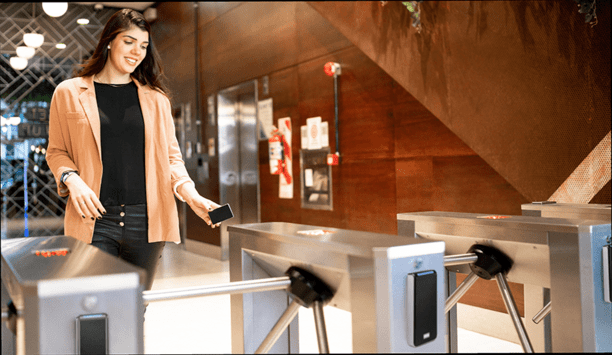
The truth behind 9 mobile access myths
Download
Access control system planning phase 2
Download
Security practices for hotels
Download